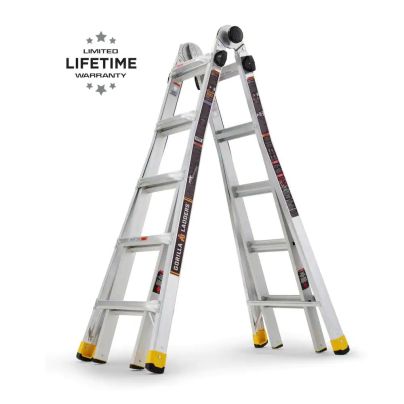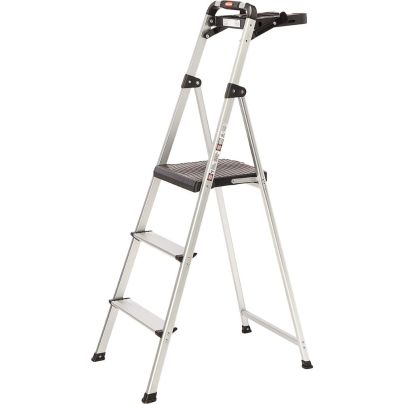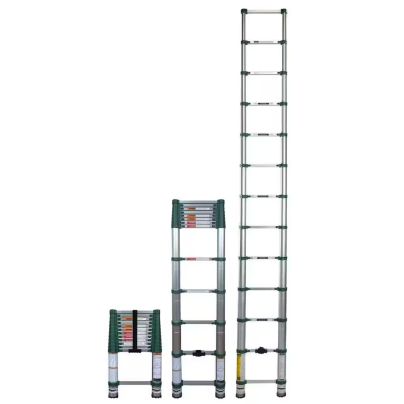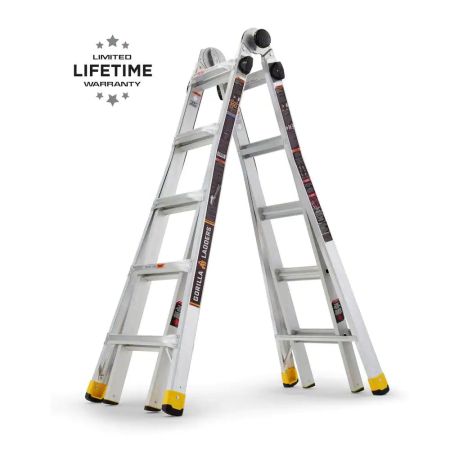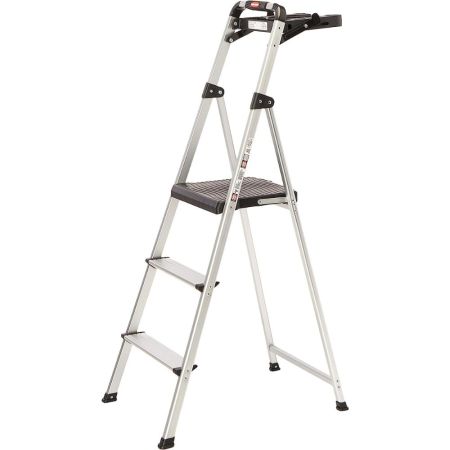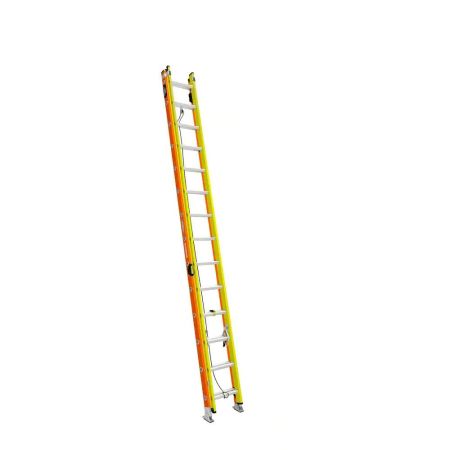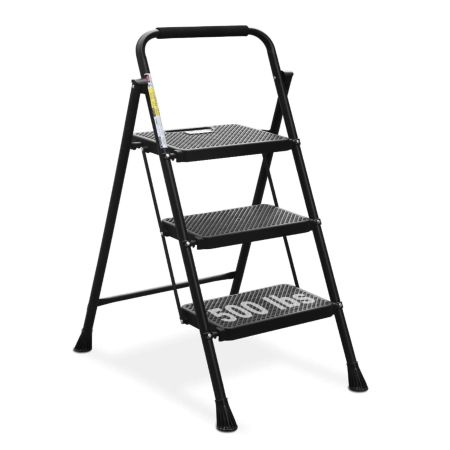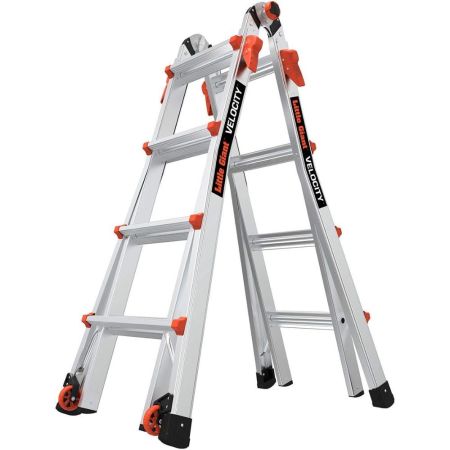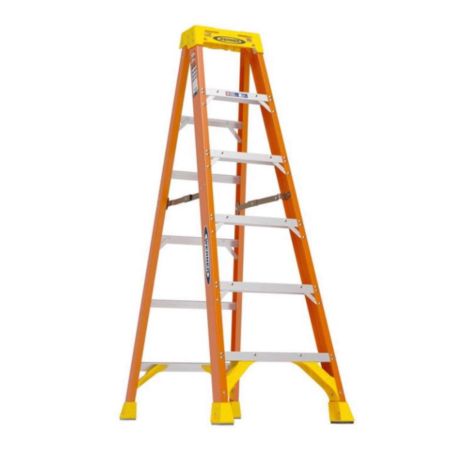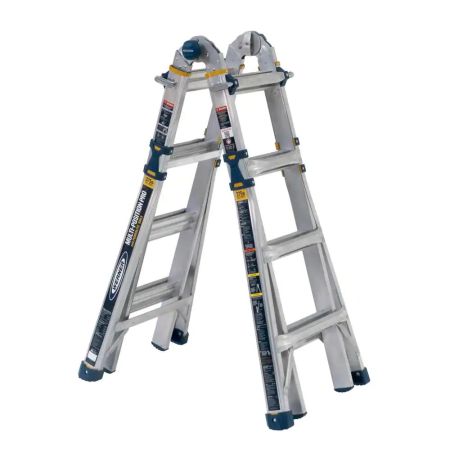We may earn revenue from the products available on this page and participate in affiliate programs. Learn More ›

The need to replace light bulbs, hang artwork, and maintain gutter cleanliness inevitably arises in every household. Having the right ladder on hand eliminates the inconvenience of borrowing from a neighbor or resorting to teetering on unstable furniture, which poses safety risks.
But don’t rush out and buy the first ladder you see in the local home improvement store, or you could end up with the wrong type for your needs—worse, you could buy an unsafe ladder.
Ladders are essential accessories, and the market is brimming with dozens of types and models, making it challenging to get the right one. No worries. We rigorously tested several high-quality ladders, judging them on quality, safety, and performance. The following ladders are all standouts. Through hands-on testing, each one earned its spot in this lineup of the best ladders. One is sure to fit your needs.
- BEST OVERALL: Gorilla 22-Foot MPXA Multi-Position Aluminum Ladder
- BEST BANG FOR THE BUCK: Rubbermaid 3-Step Aluminum Stool With Project Tray
- BEST TELESCOPING LADDER: Xtend + Climb Pro Series 780P+ Telescoping Ladder
- BEST EXTENSION LADDER: Werner 28-Foot Fiberglass Glidesafe Extension Ladder
- BEST STEP LADDER: HBTower 3-Step Portable Steel Step Ladder
- BEST MULTIUSE LADDER: Little Giant Ladder Systems Velocity Multiuse Ladder
- BEST FOR HIGH CEILINGS: Werner 6-Foot Fiberglass Single-Sided Step Ladder
- BEST HEAVY-DUTY: Werner 18-Foot Multi-Position Ladder
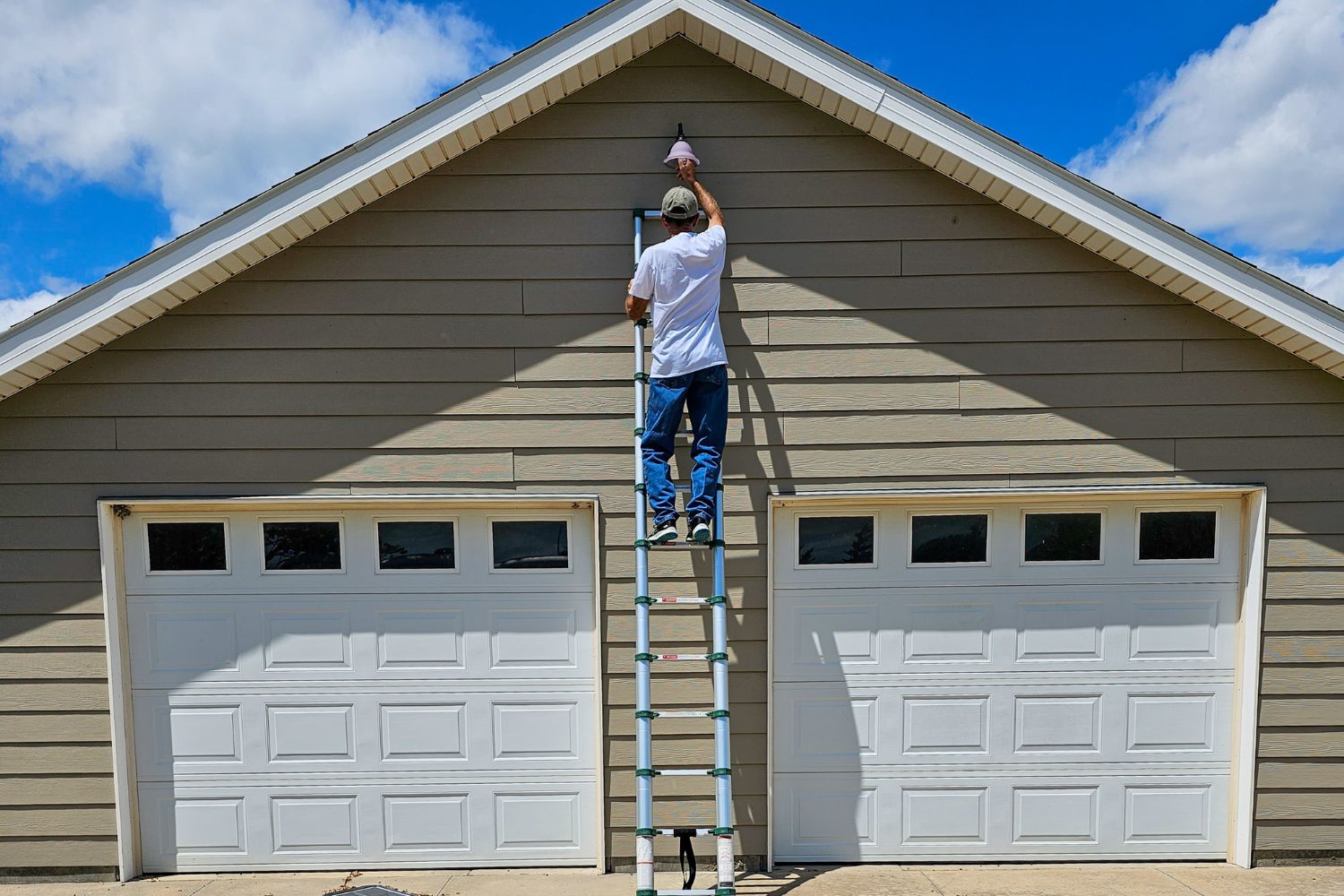
How We Tested the Best Ladders
Having the right ladder in your household inventory will save you a headache or two when an odd job arises in a hard-to-reach area. Ladders are also great to have on hand if you’re planning a renovation project, like painting or gutting an entire room.
Choosing the best ladders for our tests involved researching more than three dozen models, focusing strongly on trusted brands like Gorilla, Werner, and Little Giant. We also considered customer satisfaction and selected ladders in various categories: multiposition, extension, telescoping, and step ladders. Additionally, we factored in budget and intended use.
In the testing phase, we analyzed build quality, ease of use, and stability in real-world situations. We adjusted the ladders, climbed on them, bounced around a bit, and checked out their safety features. We used a rubric to score each ladder, ranking them by performance—the better a ladder performed on a test, the higher its score. After testing, we averaged the scores to determine each ladder’s placement and recommended applications.
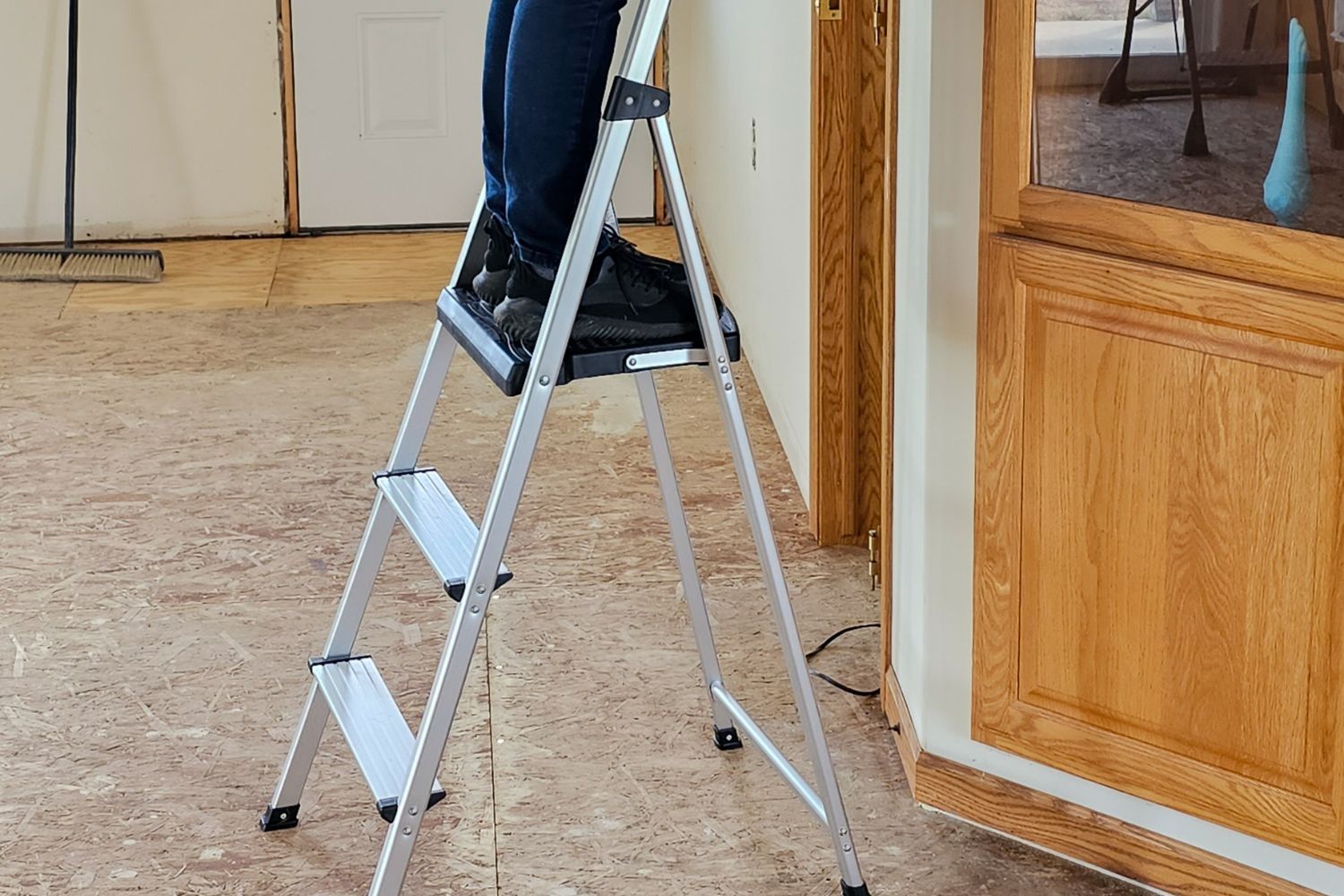
Our Top Picks
We assembled the following collection of ladders based on the results of our hands-on testing. While the types and costs for the individual ladders vary, each one earned its spot in our lineup. One is sure to be a good choice for your climbing needs.
Best Overall
Gorilla 22-Foot MPXA Multi-Position Aluminum Ladder
See ItThe Gorilla multiposition ladder earned the top spot in our lineup with its impressive 300-pound load capacity and adjustable structure. It transforms into different configurations, including an extension ladder, step ladder, wall ladder, stairway step ladder, and even a scaffold base. This adaptability eliminates the need for multiple ladders, and we found it sturdy in all configurations.
It has oversize hinges, grip locks, and nonslip feet that help to create a secure and wobble-free experience. We liked how stable the ladder was when extended to its full height. We’ve climbed on many tall ladders that had a tendency to flex, but this Gorilla model remained rigid and didn’t bounce. For a tall ladder, it’s relatively lightweight at 36.9 pounds, making it easy to carry and transport. It fits neatly into confined spaces, measuring 67 inches tall by 26 inches wide by 8.5 inches deep when folded. Despite being lightweight, it’s not rickety.
Those new to the concept of a multiposition ladder might initially struggle with the Gorilla’s various configurations and mechanisms—it took us a while to figure out how to adjust the ladder. Still, once we learned the process, it became second nature. We could quickly change from one configuration to another.
The ladder’s heavy-duty feet offer exceptional grip on various surfaces, and the 1-inch rung depth enhances standing comfort during prolonged use.
Read our full review: Gorilla 22-Foot MPXA Multi-Position Aluminum Ladder
Product Specs
- Type: Multiposition
- Maximum reach height: 22 feet
- Weight: 36.9 pounds
- Materials: Aluminum
- Load capacity: 300 pounds
Pros
- Safely supports up to 300 pounds of weight, making it suitable for various users
- Serves as an extension ladder, step ladder, wall ladder, stairway step ladder, and scaffold base
- Oversize hinges, grip locks, and nonslip feet add to the stability of the ladder
Cons
- Slight learning curve for mastering how to adjust the ladder configuration
- On the pricey side compared to single-purpose ladders
Get the Gorilla ladder exclusively at The Home Depot.
Best Bang for the Buck
Rubbermaid 3-Step Aluminum Stool With Project Tray
See ItFor simple tasks that require just a little extra height, the Rubbermaid three-step aluminum stool with project tray is an impressive choice at an attractive price point. This step ladder combines convenience, portability, and stability.
The first thing we noticed about this step ladder was the balance between weight and durability. Weighing in at a mere 8 pounds, we found it easy to carry. But, don’t let its lightness fool you—it boasts robust construction that can support up to 225 pounds.
One of the standout features of the Rubbermaid stool is a spacious project tray that provides a hands-free storage solution for a paint bucket or tools. We also liked the nonslip hand grip along the top rail.
It comes with a stable standing platform that accommodates both feet and offers a bit of room for turning to one side or the other. It features an aluminum frame and rubber-padded feet that didn’t slide or shift during testing. Plus, it has an automatic locking mechanism that holds the standing platform firmly in place for added stability.
The step ladder’s space-saving design makes it an excellent choice for those with limited storage space. It folds to a compact 56 inches tall by 19.7 wide by 3.5 inches deep when not in use, allowing users to stow it away neatly in a closet, garage, or utility room without taking up valuable space. Those looking for a budget-friendly step ladder for household tasks won’t be disappointed with this Rubbermaid model.
Product Specs
- Type: Step ladder/step stool
- Maximum reach height: 8 feet 10 inches
- Weight: 8 pounds
- Materials: Aluminum
- Load capacity: 225 pounds
Pros
- Lightweight design, sturdy construction, and weight capacity up to 225 pounds
- Secure standing platform with locking mechanism and project tray to hold tools and supplies
- Space-saving foldable design (56 inches tall by 19.7 wide by 3.5 inches deep) is perfect for small spaces
Cons
- With a 3-step height, reach is limited to just over 8 feet
Get the Rubbermaid ladder at Amazon, The Home Depot, or Walmart.
Best Telescoping Ladder
Xtend + Climb Pro Series 780P+ Telescoping Ladder
See ItFor those looking for a sturdy telescoping type ladder, the Xtend + Climb Pro 780P+ telescoping ladder is an exceptional choice. Telescoping ladders are all the rage, but in our experience, many models just don’t make the cut in terms of safety. The Xtend + Climb does.
The 780P+ ladder extends to an impressive height of 12.5 feet and offers a reach height of up to 16.6 feet. What sets the 780+P apart from standard extension ladders is its portability. The ladder collapses to just 32.25 inches, making storage and transportation a snap.
This ladder isn’t limited to seasoned professionals; it’s also a perfect companion for dedicated DIY enthusiasts who value heavy-duty tools that deliver superior performance. Despite its lightweight design (32 pounds), the 780P+ is built to withstand tough challenges. We noticed only slight flexing when the ladder was fully extended, but it was still very stable. Plus, it features nonslip feet that stayed put as we climbed up and down.
The Xtend + Climb retracts one rung at a time, which is necessary for safety. Simultaneously pressing the thumb levers at both sides of each rung collapses the rung above. While some users might find this tedious, it’s much better than smashing a finger in a ladder that retracts all at once.
Product Specs
- Type: Telescoping
- Maximum reach height: 16 feet 6 inches
- Weight: 32 pounds
- Materials: Aluminum alloy
- Load capacity: 300 pounds
Pros
- Reach up to 16 feet 6 inches with a ladder that reduces to just 32.25 inches when retracted
- Small footprint when retracted for easy storage and transportation
- Safety features include nonslip feet and one-rung-at-a-time retraction
Cons
- The legs of the ladder do not flair out for added stability, so take care to position the ladder correctly to reduce risk of tipping.
Get the Xtend + Climb ladder at The Home Depot or Acme Tools.
Best Extension Ladder
Werner 28-Foot Fiberglass Glidesafe Extension Ladder
See ItWe’ve used a lot of extension ladders over the years, and one of the biggest issues is the amount of physical strength it takes to extend the upper portion of the ladder. Werner has changed all that with its Lift Assist technology.
With Lift Assist, extending the ladder is up to 50 percent easier, sparing your back and arms from unnecessary strain. The ladder uses spring-assisted components—much like a garage door opener—to reduce the force needed to raise the ladder. All we had to do was pull downward on the included rope, and the extension part of the ladder slid easily upward—locking in place rung by rung for safety.
Werner also includes a built-in lowering assist, which provides a controlled and gentle descent. Say goodbye to jarring slams, broken fingers, and rope burns; the GlideSafe technology of the Werner fiberglass extension laddermakes safety a priority. We also liked the ladder’s dual locking system that prevents ladder extension during transport.
Another perk is the fiberglass construction of this ladder—a must for electricians or anyone working around electricity because fiberglass is nonconductive. A slight downside is the ladder’s weight (59.5 pounds), which may be challenging for some users to carry. Still, the upsides of this extension ladder—GlideSafe technology and nonconductive build—will be more important to many users.
Product Specs
- Type: Extension
- Maximum reach height: 27 feet 8 inches
- Weight: 59.5 pounds
- Materials: Fiberglass
- Load capacity: 300 pounds
Pros
- Lift Assist technology extends the ladder using 50 percent less effort, reducing strain on your back and arms
- Built-in lowering assist controls descent, eliminating slamming, finger injuries, and rope burns
- Dual locking system prevents unintended ladder extension during transport, enhancing safety
- Nonconductive fiberglass rails make it ideal for working near electricity
Cons
- Weighing 59.5 pounds, the ladder might be a bit heavy for some users to carry and position alone
Get the Werner extension ladder at The Home Depot,Acme Tools, or Werner.
Best Step Ladder
HBTower 3-Step Portable Steel Step Ladder
See ItThe HBTower three-step folding step ladder redefines what a short ladder can offer. Opened, the HBTower measures 40.9 inches tall by 20.1 inches wide by 26.8 inches deep, while its folded dimensions of 44.5 inches tall by 20.1 inches wide by 1.6 inches deep make it convenient to carry and stow. It weighs just 11.5 pounds but comes with a substantial load capacity of up to 500 pounds, making it suitable for many users.
When open, the step ladder locks in place, but we found it took some force to engage the safety lock, which would not lock until we stepped on the top platform. It also took a solid tug to release the lock and fold the step ladder after use.
The HBTower features two oversize steps (14.2 inches wide by 7.9 inches deep) and a larger standing platform that measures 14.2 inches wide by 10.6 inches deep, which we found handy for standing with both feet and turning to the side. The top rail has nonslip foam padding, making it comfortable to grip, and the large rubber feet enhance traction while preventing scratches on floors. No bells and whistles with this one—just a good solid build and quality materials that should last for years.
Product Specs
- Type: Step ladder
- Maximum reach height: Approximately 7 feet 5 inches
- Weight: 11.5 pounds
- Materials: Iron, polypropylene
- Load capacity: 500 pounds
Pros
- Sized for practicality and portability, making storage and transport a breeze
- High-grade steel frame and safety lock for secure use
- Rubber hand grip, wide nonslip pedals, and large rubber feet enhance stability
Cons
- May take force (stepping on the top step) to lock the platform into place
Get the HBTower ladder at Amazon, Sears, or HBTower.
Best Multiuse Ladder
Little Giant Ladder Systems Velocity Multiuse Ladder
See ItLittle Giant’s Velocity ladder offers an efficient solution for various climbing tasks. This versatile laddercan be configured as an A-frame ladder, extension ladder, staircase ladder, 90-degree ladder, or scaffold base. Its flexibility eliminates the need for multiple ladders, making it a space-saving and cost-effective choice. Its locking adjusters allowed us to make quick and secure changes to the ladder’s height and configuration.
We really liked the ratchet leg levelers we could use to stabilize the ladder on uneven ground. All it took was a push with the toe of a shoe on the lever—located just above the bottom of the ladder leg—and the leg extended to meet the ground where the ground was sloping. That sure beats sticking a brick or board under the low side to make the ladder level.
The Velocity ladder offers a weight capacity of up to 300 pounds, making it suitable for various users and tasks. It offers an impressive 18-foot 1-inch reach when fully extended but measures just 4 feet 7 inches in retracted mode for storage.
Like many multiposition ladders, we had to learn how the Little Giant’s locks and adjusters operated, which took some time, but once we understood the process, adjusting the ladder was second nature. If you’re looking for a single ladder that will serve multiple ladder functions, the Little Giant Velocity deserves a closer look.
Product Specs
- Type: Multiposition
- Maximum reach height: 18 feet 1 inch
- Weight: 30.5 pounds
- Materials: Aluminum
- Load capacity: 300 pounds
Pros
- Offersmultiple configurations, including A frame, extension, staircase, 90 degree, and scaffolding
- Integrated leg levelers provide stability on uneven surfaces and prevent wobbling or tilting of the ladder
- Tip & Glide wheel system makes it easier to move the ladder from place to place without strain
- Constructed from lightweight aluminum, the ladder offers a balance of strength and portability
Cons
- While the ladder is designed for versatility, adjusting and transforming it between different configurations might take some time and practice to master
Get the Little Giant ladder at Amazon, Staples, or Acme Tools.
Best for High Ceilings
Werner 6-Foot Fiberglass Single-Sided Step Ladder
See ItA solid step ladder is essential for doing overhead work, such as painting a ceiling, and Werner’s 6-foot fiberglass model fits the bill. Engineered to be durable and safe, this ladder is an asset for those seeking a dependable climbing tool.
With a load capacity of up to 300 pounds, the ladder is well equipped for heavy-duty tasks and accommodating various users.
It comes with Werner’s patented Locktop system with several cutouts and a steel side strip for securing magnetic tools. This streamlines workflow and organizes the workspace efficiently, enhancing productivity by eliminating the need for constant up-and-down tool retrieval. We liked the hook on the backside of the ladder for hanging a paint can by its handle—that’s preferable to perching the can on the top where it could tip.
When folded out, the Werner step ladder was stable and didn’t wobble when we tested it. Even when we stood on the upper step—which is not intended for safe standing—the ladder didn’t wobble and felt secure.
A plus for electricians or anyone who works with wiring, this ladder comes with nonconductive fiberglass rails. The ladder is also weather-resistant, making it suitable for outdoor use without compromising performance. However, at 22 pounds, this one is on the heavier side for a small step ladder due to its fiberglass construction. If you don’t plan on working around electricity, a lighter-weight aluminum model may be a better choice.
Product Specs
- Type: Step ladder
- Maximum reach height: 10 feet 4 inches
- Weight: 22 pounds
- Materials: Fiberglass
- Load capacity: 300 pounds
Pros
- Load capacity of 300 pounds, making it suitable for heavy-duty tasks and a range of users
- Upper tray holds tools for convenience, storage, and easy access
- A steel plate on the top allows for the use of magnetic accessories
- Ladder is durable and stable—doesn’t wobble or tilt when in use
- Fiberglass rails are nonconductive, making it safer for working near electricity
Cons
- At 22 pounds, this ladder is slightly heavier than aluminum models of the same size
Get the Werner single-sided ladder at Ace Hardware, The Home Depot, or Grainger.
Best Heavy-Duty
Werner 18-Foot Multi-Position Ladder
See ItAmong the several multiposition ladders we tested, the Werner 18-foot model had its work cut out for it, but it rose to the challenge. This is a well-built adjustable ladder that will hold up to heavy-duty tasks.
This versatile climbing tool operates as five ladders in one, transitioning between an extension, double-sided twin-step, stairway, and a 90-degree wall ladder. Additionally, the ladder disconnects at its center point to form two individual scaffold bases. It was rock-solid in all configurations except when we used it as a scaffold base—and then we found a slight wobble. It was nothing that would present a safety hazard, but it registered enough that we could feel when we stepped on the scaffold plank.
The ladder features aluminum j-locks and oversize impact-resistant push knobs. These elements improve usability and should contribute to the ladder’s longevity, but it takes a few minutes to figure out exactly how they operate. A big perk is the ladder’s flared bottom and slip-resistant feet that add an extra layer of stability and safety.
Overall, this is a very nice ladder that takes the place of multiple other ladders and its high-quality build makes it suitable for pros or DIYers.
Product Specs
- Type: Multiposition
- Maximum reach height: 18 feet
- Weight: 31.5 pounds
- Materials: Aluminum
- Load capacity: 375 pounds
Pros
- 5 ladders in 1, which saves space and provides diverse functionality
- With 24 adjustable positions, this ladder replaces multiple other ladders
- Extra-wide flared bottom and slip-resistant feet provide a stable climbing foundation
- Combines lightweight build with a substantial load capacity, making it a versatile choice for most users
Cons
- Slightly wobbly when put in scaffold base configuration (may be exclusive to the one tested)
Get the Werner multiposition ladder at The Home Depot.
Jump to Our Top Picks
What to Consider When Choosing a Ladder
After determining the ladder type that suits your needs, it’s essential to take into account factors like material construction, height, weight capacity, and any additional features. These elements collectively contribute to ladder safety, overall efficiency, and suitability for specific tasks.
Types of Ladders
Ladders come in four main designs, all portable but each suited to different household or jobsite projects, indoors or out, at low or high heights. Read on for some of the most common ladder styles.
Step Ladder
The smallest type of self-supporting ladder, a step ladder stands independently on a level, nonslip surface. It typically measures no more than 4 to 6 feet tall from the base to the top cap (the uppermost platform).
These foldable, nonadjustable ladders aid in one-person indoor tasks that only need a little boost. Step ladders help you change light bulbs, reach the top shelves, and clean hard-to-reach areas. On the smallest models, you can climb every step, including the top cap.
A-Frame
A-frame ladders are nonadjustable, self-supporting ladders that measure 4 to 20 feet tall when standing on a level, nonslip surface. This height might make an A-frame or platform ladder the best type for home use, especially as an attic ladder.
These versatile ladders are handy for ceiling-fixture installation, first-floor window replacement, and gutter cleaning on 1-story homes. A hinged design makes them easy to use as an attic ladder or simple to collapse and store. A-frame models come in two varieties: single side or twin step.
- Single-side A-frame ladders have a single climbable rail with flat steps that successively narrow in width as they get higher. A rear rail, while present, is typically nonclimbable. The top cap and the topmost step of the front rail likewise can’t support a person. Typically these ladders are used outdoors or as an attic ladder.
- Twin-step A-frame ladders have steps on both the front and rear rails. Depending on the model, these sturdy ladders can support one or two people at a time.
Extension
Extension ladders require a structure such as a wall to prop up against. They should rest at an angle of around 75.5 degrees from the supporting structure for optimal stability.
Measuring up to 14 feet when collapsed, one or more sections of an extension ladder extend to increase the length up to 72 feet. Extension ladders rise to tasks like painting siding, hanging Christmas lights, and cleaning second-story gutters. These ladders contain square or D-shaped rungs considerably narrower than those found on step or A-frame ladders. For this reason, you’ll want to wear shoes with good traction when climbing an extension ladder.
Telescoping
Unlike extension ladders, telescoping ladders are more versatile. You can extend the length of the ladder by the foot and lock it into position at the desired height. A telescoping ladder usually ranges from about 8 to 12 feet high when fully extended.
Made of either fiberglass or aluminum, telescoping ladders weigh between 16 and 42 pounds. When folded, the small footprint and lightweight design add up to a portable ladder that fits in the trunk of a vehicle or a small closet. When leaning these straight laddersagainst the wall, use the 1-to-4 rule for safety: For every 4 feet of height, move the base of the ladder 1 foot from the wall.
Multiposition
The best multiposition ladder (or multiuse ladder) includes hinges that lock in multiple configurations. These models transform into self-supporting and wall-supported configurations, including A-frames, extension ladders, scaffolds, and more. Depending on the design, multiposition ladders can reach up to 30 feet.
As the name implies, multiposition ladders help tackle a variety of jobs around the house that may require various ladder types, or a single job that would benefit from more than one ladder type. For example, painting a wall along a staircase might require the ladder to lean against the wall at the base of the staircase and then fold into an A-frame position on the steps.
Only unlock/lock and reposition the hinges from the ground level. One should not attempt these adjustments while climbing the ladder.
Material
Wood, fiberglass, and aluminum are the three most common materials used in both traditional and fire escape ladders. Keep the following material characteristics in mind while shopping:
- Aluminum is the lightest option and least likely to corrode. This metal is among the most effective conductors of electricity; as such, aluminum ladders are not recommended for electrical work or use near electrical lines.
- Fiberglass models are heavier than aluminum ladders but more robust. As a nonconductive material, fiberglass ladders will serve users well in electrical and nonelectrical applications. They may cost more than aluminum and wood models.
- Wood ladders are often the most economical, but they’re heavier and may not last as long. Wood rots if left outside. As such, these ladders work best indoors.
Reach Height
If you must strain your arms, stand on tiptoe, or exceed the tallest climbable step to reach the desired height, that means that the ladder is too short—with potential consequences ranging from minor discomfort to dangerous slips and falls. As such, it’s important to consider reach height, or the highest point a person can safely access while standing on the ladder. Reach height can be more or less than the height of a ladder and varies by type:
- Step, platform, and A-frame: ladder height, plus 4 feet
- Multiposition: ladder height, plus 1 foot
- Extension and telescoping: ladder height, minus 1 foot
For instance, most adults can reach an 8-foot ceiling using a 4-foot step, platform, or A-frame ladder. To access first-floor gutters (usually 11 feet high), a ladder between 7 and 12 feet is typically sufficient. Those who prefer self-supporting ladders can opt for a 7-foot platform, A-frame, or a 10-foot multiposition model. Alternatively, a 12-foot extension or telescoping ladder can be positioned against a building.
Load Capacity
The load capacity is the maximum weight a ladder will hold. Ladders fall into five categories based on how much weight they support:
- Type IAA ladders hold up to 375 pounds
- Type IA ladders hold up to 300 pounds
- Type I ladders hold up to 250 pounds
- Type II ladders hold up to 225 pounds
- Type III ladders hold up to 200 pounds
When determining the load capacity needed for a project, factor in the user’s weight, plus the weight of the tools and supplies needed to carry up or store on the ladder (if it has a built-in tray or shelf).
Accessories
Many modern ladders include built-in accessories that boost storage capacity, reduce strain, and protect nearby surfaces. Popular add-ons include:
- A pail shelf, usually extending from the rear rail level with one of the steps to hold paint buckets or utensils.
- Ladder caps that slide over the rail ends to prevent damage to whatever surface the ladder is propped against.
- Podiums, or large platforms that take the place of one or more steps. A podium ladder provides extra foot room during long or intensive jobs and is sometimes called a platform ladder.
Tips for Using a Ladder
Like any other tool, a ladder should be treated as a potential hazard. Incorrect use or selecting the wrong ladder for a task can lead to accidents. Even a well-constructed ladder comes with risks if it’s not positioned correctly, climbed responsibly, or chosen thoughtfully.
Begin by selecting a ladder type that matches the task’s requirements and offers adequate height, preventing overstretching. Verify the weight limit or load capacity considering your weight and the weight of tools and supplies you’ll be carrying.
When positioning the ladder against a structure, ensure it’s set at the recommended angle, especially if it’s not self-supporting. All ladder legs should be securely placed on stable ground. Maintaining three points of contact at all times is crucial—this involves having two feet and one hand on the rungs.
Extending and collapsing ladders, such as extendable and telescoping models, should be done with care to prevent hand or finger injuries. Wear footwear with excellent traction, preferably sturdy work boots or shoes, to ensure stability. Avoid using the ladder in adverse weather conditions to prevent accidents.
Here are a few more essential points to remember when using your new ladder:
- Climbing technique: Never ascend with your back to the ladder or pass beneath it. Always face the ladder while climbing.
- Avoid side rails for support: Refrain from using the ladder’s side rails to pull yourself up. Stepping on the top cap or highest rail is also discouraged.
- Tool placement: Don’t leave tools on ladder steps; they can create tripping hazards and instability.
- Secure the ladder: Always lock the ladder in place while using it to ensure stability and prevent unexpected movement.
FAQs
For more information about the best ladder, check out these answers to some of the most common questions. If additional concerns arise, contact the manufacturer.
Q. What is the best ladder brand?
Little Giant Ladder Systems, Gorilla, and Werner are trustworthy brands that produce some of the safest ladder options.
Q. Which is better: a fiberglass or aluminum ladder?
Aluminum is the lightest option and least likely to corrode, but this metal is among the most effective conductors of electricity. That means you shouldn’t use metal ladders for electrical work or near electrical power lines.
Fiberglass, while heavier than aluminum, is stronger and more versatile. It’s nonconductive, so you can use fiberglass ladders for electrical and nonelectrical applications.
Q. What is the maximum height I can work from a ladder?
An adult standing can safely reach about 4 feet higher than a step ladder’s height. If using a multiposition ladder, reaching 1 foot higher than the ladder’s height is considered safe. For an extension ladder, 1 foot below the ladder’s height is regarded as the maximum reach. For safety, do not work above the manufacturer’s recommended reach on any ladder.
Q. How do I pick a ladder size?
An appropriately sized ladder has enough height that you don’t have to reach too much or stand on your toes. Reach height (the highest point a person can safely access while standing on the ladder) can be more or less than the height of a ladder and varies by type.
- Extension ladders: For extension ladders, it’s recommended that the ladder be 7 to 10 feet longer than the highest point it will support or contact. This point can be the wall or roof line. This additional length accounts for proper setup, overlapping of ladder sections, height restrictions of the highest standing level, and, where applicable, the extension of the ladder above the roof line. For stability, the highest standing level is typically located four rungs down from the top.
- Step ladders: On step ladders, the highest permitted standing level is typically two steps down from the top. This rule is essential for maintaining balance and preventing falls. Additionally, it’s important to note that a person’s maximum safe reaching height is approximately 4 feet higher than the ladder’s height. For instance, a standard individual can safely reach an 8-foot ceiling using a 4-foot ladder.
Q. What is the best ladder for home use?
One of the best multiposition models is the Little Giant Ladders Systems Velocity ladder, with extensive reach and adjustable A-frame, extension, trestle and plank, staircase, and 90-degree configurations.
Why Trust Bob Vila
Bob Vila has been America’s Handyman since 1979. As the host of beloved and groundbreaking TV series including “This Old House” and “Bob Vila’s Home Again,” he popularized and became synonymous with “do-it-yourself” home improvement.
Over the course of his decades-long career, Bob Vila has helped millions of people build, renovate, repair, and live better each day—a tradition that continues today with expert yet accessible home advice. The Bob Vila team distills need-to-know information into project tutorials, maintenance guides, tool 101s, and more. These home and garden experts then thoroughly research, vet, and recommend products that support homeowners, renters, DIYers, and professionals in their to-do lists.
Meet the Tester
Glenda Taylor is a product tester and writer specializing in the construction, remodeling, and real estate industries. She and her husband own a general contracting company, and Taylor is experienced in both residential and commercial building applications. She tests a wide range of power tools as well as other home improvement, household, and lawn-and-garden products.
Additional research provided by Manasa Reddigari and Tiffany Lewis.
